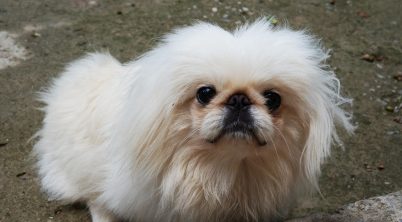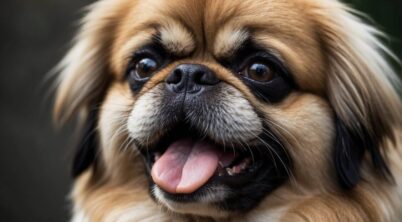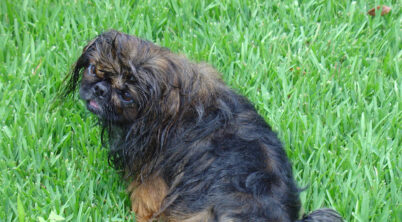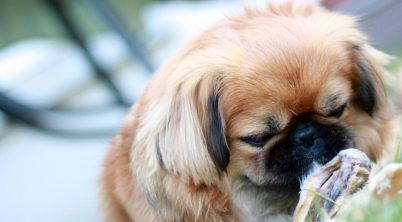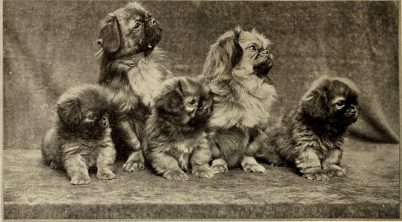Determining the appropriate amount of food for a Pekingese requires understanding their specific dietary needs. As a toy breed with a distinctive physical build, the Pekingese has nutritional requirements that differ from larger breeds. Their diet should be carefully measured to maintain optimal health, taking into account factors such as their age, size, activity level, and metabolism.
Feeding a Pekingese too much can lead to obesity, a common health issue within the breed, due to their small frame and propensity for lower activity levels. Conversely, inadequate nutrition can lead to undernourishment and associated health problems. Therefore, it’s crucial to balance the quantity with high-quality dog food that provides the necessary nutrients for the well-being of this regal breed.
Typically, an adult Pekingese thrives on about 1/2 to 1 cup of dry food per day, divided into two meals. The caloric content of the dog food is an important consideration, and adjustments should be made to align with the pet’s energy requirements. For younger Pekingese puppies, more frequent feedings are necessary to support their growth and development. It’s recommended to consult a veterinarian to tailor a feeding regimen that supports a Pekingese’s health through all stages of life.
Table of Contents
Pekingese How Much Food
Feeding a Pekingese requires attention to the dog’s age, size, and activity level. Adult Pekingese typically need about 1/2 to 1 cup of dry food per day, which should be split into at least two meals. This portion maintains their energy throughout the day without leading to weight gain.
For Pekingese puppies, the feeding amount and frequency differ as they grow. They generally eat more often—three to four meals per day—to support their rapid development. Puppies from 6 to 7 weeks old may consume 3/4 to 1/2 cup of food at each meal. As they age, the frequency reduces to twice daily feedings by four months.
Dogs’ nutritional requirements change over time. The Pekingese, if active, may require slightly more food, while a less active or older dog may need less to prevent obesity. Here’s a quick reference guide:
- Puppies (under 4 months): 3-4 meals daily
- Adults: 1/2 to 1 cup per day, divided into 2 meals
- Senior or less active dogs: May require fewer calories
Choose a high-quality dog food that lists an animal protein as the first ingredient. Additionally, ensure it meets the dog’s energy needs, typically around 389 kilocalories per cup. It’s essential to follow the specific brand’s feeding guidelines and adjust according to one’s Pekingese needs and vet’s recommendations. Fresh water should always be available to support hydration alongside their diet.
Understanding Pekingese Dietary Needs
When considering the dietary needs of a Pekingese, one must balance the right mix of proteins, fats, and carbohydrates with the dog’s level of physical activity to maintain optimal health and prevent health problems such as obesity.
Optimal Nutrient Balance for Pekingese
Protein: An essential nutrient for muscle development and repair, protein should constitute a significant portion of a Pekingese’s diet. High-quality animal proteins like chicken, lamb, or fish are preferable sources.
Fats: While fats are necessary for energy, they must be given in moderation as Pekingese can easily gain weight due to their small size and lower calorie needs. Omega-3 and omega-6 fatty acids are important for maintaining a healthy coat and skin.
Carbohydrates: Carbohydrates provide energy and should come from complex sources like brown rice or vegetables, which offer the added benefit of essential nutrients and fiber, aiding in digestion.
The Role of Exercise in Diet
Calorie Intake: The energy needs of a Pekingese vary with their level of physical activity. Less active dogs require fewer calories, so their diet should be adjusted to avoid weight gain.
Exercise: Regular exercise is essential for Pekingese, not only for weight management but also because, as a brachycephalic breed, they are prone to health issues related to their respiratory system. A consistent but gentle exercise routine supports their overall well-being and helps prevent obesity, which can further strain their breathing and stomach.
Maintaining ideal body weight is pivotal for Pekingese health. Their diet should be monitored, encouraging regular, light exercise to match their caloric intake with their energy expenditure.
Feeding Your Pekingese: Methods and Portions
Proper feeding is crucial for a Pekingese’s health, taking into account their daily calorie intake and the type of food provided. Adhering to feeding guidelines ensures they receive the necessary nutrients without the risks of overfeeding.
Pekingese Feeding Chart and Amount Guidelines
A Pekingese requires carefully measured portions tailored to their age, weight, and activity levels. An adult Pekingese typically needs about 1/2 to 1 cup of dry food per day, divided into two meals. For an 11-year-old Pekingese, the recommended portion is 0.9 cups of dry food daily. Owners should consult a feeding chart for precise amounts and frequency, considering factors like the dog’s weight to avoid both underfeeding and overfeeding which can lead to obesity and strain on their digestive system.
Feeding Chart Example:
| Age of Pekingese | Daily Amount of Dry Food |
|---|---|
| 6 to 7 weeks old | 3/4 cup (3-4 meals) |
| Adult (standard activity) | 1/2 to 1 cup (2 meals) |
| Senior (11 years old) | 0.9 cup (2-3 meals) |
Adjust the amounts based on the dog food labels and your Pekingese’s individual needs. If you notice weight gain or loss, consult with a veterinarian to reassess your dog’s daily caloric needs.
Wet Food vs. Dry Food: Understanding the Differences
When deciding between wet food and dry food for your Pekingese, consider the benefits each offers. Wet food provides hydration and is often more palatable, making it a suitable choice for Pekingese with picky appetites. It can also be easier for dogs with dental issues to consume. However, wet food may spoil more easily once opened and tend to have a higher cost.
On the other hand, dry food, or kibble, is convenient for measuring and typically more economical. It also helps to clean teeth by reducing plaque build-up. Dry food’s lower moisture content means it lasts longer once the package is opened. Always look at the dog food labels to assess the quality and nutritional content whether you choose wet or dry food.
Regardless of the type, maintaining proper portion control is essential to prevent overfeeding, which can lead to obesity and associated health issues. A balanced diet, suited to the Pekingese’s lifestage, and consideration of their specific dietary needs, is key to supporting a healthy digestive system and overall well-being.
Special Considerations for Pekingese Health
In the realm of canine health, the dietary habits of a Pekingese have a direct impact on its overall well-being. Specific health issues, such as obesity and joint health, can be managed effectively through tailored nutrition and exercise routines.
Addressing Health Issues Through Diet
Pekingese dogs have a tendency towards certain health problems that can be exacerbated by improper diet. High-caloric diets may lead to obesity, which in turn can put additional stress on their compact skeletal structure. To manage weight and digestive issues, it’s crucial to provide a diet with an appropriate caloric intake, rich in proteins and fats, and low in fillers that could cause gastrointestinal upset.
A well-balanced diet also contributes to dental health. Pekingese should have regular dental check-ups and receive dry food that aids in reducing tartar buildup. In terms of skin allergies, ingredients known to reduce inflammation or eliminate common allergens (like grain-free formulas) can be helpful.
It’s also important to note that Pekingese are prone to breathing problems due to their brachycephalic nature. A healthy diet can help prevent excessive weight gain, which would otherwise exacerbate such breathing difficulties.
| Health Issue | Diet Consideration |
|---|---|
| Obesity | Low-calorie, High-protein, Portion-controlled |
| Digestive Issues | Easy-to-digest ingredients, Probiotics |
| Dental Health | Dry kibble to reduce plaque |
| Skin Allergies | Hypoallergenic ingredients |
| Breathing Problems | Avoid Overfeeding |
Exercise and Joint Health in Pekingese
Pekingese are not as active as larger breeds, yet regular exercise is essential for maintaining joint health and mobility. Their exercise regimen should consist of moderate activities which support joint function without putting undue pressure on them. Activities like leisurely walks and gentle play are recommended.
Due to their small stature and propensity for joint issues, including heatstroke, overexertion must be avoided, especially in hot weather. Pekingese benefit from activities that occur during the cooler parts of the day and in shaded, ventilated areas.
Maintaining an ideal weight is essential for joint health, to prevent strain from excess weight. A carefully controlled diet in combination with a regular, but mild, exercise routine can mitigate potential health issues related to the joints.
| Aspect | Consideration |
|---|---|
| Exercise Type | Low-impact (e.g., walking, gentle play) |
| Duration | Short sessions, frequent |
| Intensity | Moderate, avoid overheating and exhaustion |
| Weight Control | Monitor to ease joint stress |
Puppy Nutrition and Feeding Routines
Proper nutrition is essential for Pekingese puppies as they grow. They require balanced meals specifically formulated for small breeds to support their development.
Appropriate Food for Pekingese Puppies
Pekingese puppies thrive on high-quality puppy food that caters to their needs for energy and growth. The food should be rich in protein to support muscle development and contain adequate fats for energy, as well as essential vitamins and minerals for overall health.
- Dry Kibble: Small breed formula with appropriately sized pieces for their little mouths.
- Wet Food: Can be mixed with dry food for added hydration.
One should avoid human food and foods high in fillers as they do not provide the balanced nutrition puppies require.
Developing a Feeding Schedule for Growth
Setting a consistent feeding schedule helps Pekingese puppies maintain steady growth and avoid obesity.
- 6 to 7 Weeks Old: Feed ¾ to ½ cup of food, 3 to 4 times a day.AgeAmount of FoodFrequency6-7 weeks old¾ to ½ cup3-4 times/day
As they grow, the amount and frequency will change, always guided by the puppy’s activity levels and physical condition. Feeding should be divided into two meals a day once they reach adulthood. It’s essential to monitor their growth and adjust portions accordingly.
Maintenance and Lifestyle
The maintenance and lifestyle of a Pekingese involve a detailed grooming routine and understanding their feeding behavior, both crucial for their well-being. As a toy breed with a distinct personality, the Pekingese requires regular care to maintain its health and temperament.
Grooming and Its Relation to Diet
Grooming: The Pekingese sports a luxurious double coat that necessitates regular grooming. The outer coat is long and straight, and the undercoat is soft and thick. Routine brushing is essential to prevent matting and to distribute natural skin oils that keep the coat healthy.
Diet: Proper nutrition plays a vital role in maintaining the coat’s condition. A diet rich in proteins and omega fatty acids promotes a shiny, strong coat, reflecting a Pekingese’s overall health. It’s important to tailor their diet to their grooming needs, ensuring they receive all the necessary nutrients for a healthy coat.
Behavioral Aspects of Feeding
Temperament: Pekingese are known for their independent and sometimes stubborn nature. When it comes to feeding, they may exhibit fussy eating habits that reflect their temperament. Understanding their personality is key to developing a successful feeding routine.
Feeding Routine: Consistency in feeding helps to manage their expectations and behavioral issues. They thrive on a regular schedule, which includes measured portions to prevent overfeeding. The quantity of food recommended typically ranges from half a cup to three-quarters of a cup daily, divided into two meals for adults, to ensure they maintain a healthy weight for their small stature.
Barking and Feeding: As a member of the toy group, a Pekingese may bark to communicate, even when it comes to food. They are vocal about their needs and desires, which can include signaling when it’s time to eat or when they’re dissatisfied with their meal. Managing their barking behavior is important during feeding times to maintain a peaceful environment.

